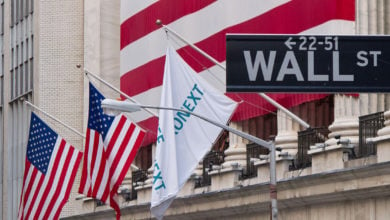The statistics are shocking. In 2004, 13.5 million U.S. households were “food insecure,” according to the Food Research and Action Center. That means more than 38 million people, including nearly 14 million children, are living with hunger or on the brink of hunger.
 Some 38 million people in the United States are “food insecure.” Photo: Steve Nagy |
These numbers grew every year from 1999 to 2004, the last year for which figures are available. Between 1999 and 2002, 3.9 million people joined the official ranks of the “food insecure.” Even these appalling figures are suspect, coming as they do from a government that consistently underestimates poverty and the poverty line.
African American and Latino families experienced “food insecurity” at close to double the national average rate.
The biggest increase and highest rate of food insecurity is in Texas, where it rose from 13.9 percent in the period 1999 to 2001, up to 16.4 percent in the period from 2002 to 2004. Nine of the 10 worst states are so-called “right-to-work” states, where laws have made it much more difficult to organize unions.
All signs indicate that hunger has continued to spread rapidly since 2004—at the same time that government anti-poverty programs continue to be cut back or eliminated altogether.
Across the country, in cities, towns and rural areas, local emergency efforts like school “backpack clubs” have been organized in the past year to try to address the growing crisis. No such urgent effort is coming from the federal government in Washington, which instead is busy spending more than $1.3 billion per day—around $55 million per hour—on the military.
 The federal minimum wage has not been raised since 1997. Photo: Bill Hackwell |
While slashing housing, nutrition and welfare programs, the federal government has sharply increased subsidies to agribusiness over the last decade—much of it paid to not grow crops. Over the past 10 years, agricultural subsidies have cost $172 billion. In 2005, when agriculture industry profits hit $72 billion, “the federal government handed out more than $25 billion, 50 percent more than the amount it pays to families receiving welfare.” (Washington Post, July 2, 2006)
About half of all agricultural subsidies are paid to not grow a particular crop.
U.S. agribusiness today has the capacity to feed not only all people living in this country, but also much of the world where hunger is far more widespread and catastrophic. Official estimates say that at least 850 million of the world’s 6 billion people are suffering from malnutrition. The number is probably considerably higher.
There can no longer be any real doubt that the agricultural resources exist to wipe out hunger worldwide.
So why hasn’t hunger been eliminated? Why are nearly a billion people continuing to suffer the indescribable pain and damage caused by food deprivation? Why is the government paying tens of billions of dollars not to grow food, while tens of millions go hungry in the richest country on earth?
The answer, in a word, is capitalism.
Under capitalism, profit drives production, causing the capitalist owners to set the wheels of production in motion. Meeting people’s needs is not the priority; it’s making money, and as much money as possible.
Production in the capitalist system is organized around the much-heralded market, that is, for sale. If the product cannot be profitably sold, the capitalist has no interest in producing it, regardless of how vital it is to human survival, or how much suffering its non-production might cause.
Nothing makes the inherently criminal nature of the capitalist system clearer than the relationship between the food production industry and hungry people.
Cutbacks amid downturn
One of Democratic President Bill Clinton’s promises when he ran for president in 1992 was to “end welfare as we know it.” Going after poor people has long been a staple of craven bourgeois politicians.
Two years later, then-House-speaker Newt Gingrich and the Republicans swept to victory on the same platform. In 1996, the Republican Congress and Democratic White House eliminated Aid to Families with Dependent Children and many other “social safety net” programs.
These programs were a product of the working-class struggles of the 1930s. They were an admission that since unemployment is a permanent feature of capitalism, the capitalists and their government must provide the means of survival for those without jobs.
Because the capitalist economy in the mid-1990s was in the boom, or expansion, phase of its cycle and more jobs were available, the social cost of cutting the programs was not immediately apparent. That came only with the capitalist downturn and widespread layoffs beginning in 1999 and 2000. It was then that hunger, already affecting millions, began to rapidly spread.
Rising unemployment combined with the disappearance of social programs increased the desperation of many workers seeking a job—any job.
Keeping the minimum wage low
In this context, the White House and Congress did its part for the capitalist class they serve by blocking any increase in the minimum wage.
On June 21, Senate Republicans blocked a vote on raising the minimum wage, rejecting an extremely modest Democratic proposal that would have increased it to $7.25 per hour by Jan. 1, 2009.
It has been nine years since Congress approved an increase in the federal minimum wage. Since then, it has been frozen at a miserable $5.15 an hour. Workers under the age of 20 can be paid a federal minimum of $4.20 per hour for their first 90 days of employment. Thirty U.S. states adhere to the federal minimum wage.
The real buying power of the minimum wage adjusted for inflation is now at its lowest level since the late 1940s. At its peak, in 1968, the then-minimum wage of $1.60 an hour would be worth $9.12 in 2006 dollars, nearly $4 per hour more than today’s minimum.
Earning the present minimum wage leaves an individual well below the poverty line. Working full-time for a year making $5.15 an hour amounts to $10,712. Paying for rent, utilities, other necessities and food is impossible with that kind of paycheck in any part of the country.
The same could be said, of course, for the proposed $7.25 minimum wage.
Two days later, Congress voted to increase its own salaries by $3,300 per year, the ninth Congressional salary hike since the last increase in the minimum wage.
Congressional opponents, engaging in maximum cynicism, tried to cloak their opposition to raising the minimum wage with concern for working people. Congress member Mike Enzi from Wyoming said that an increase would “stifle job creation and shut the employment door on the very individuals we are trying to help (sic).”
It’s the same argument every time an increase is proposed. And yet at no time after a minimum wage increase—whether in 1997, 1990, or 1980—did a single McDonald’s or other low-wage employer go out of business.
Simply crunching a few numbers exposes the real motives of these so-called “representatives of the people.” There are an estimated 1.9 million workers making the minimum wage or less. Based on a 40-hour week, if their pay was raised to $7.25 an hour, the total amount of additional wages would be about $8.3 billion dollars. According to some economists, that would be good for the economy—more spending, more production, more jobs and so on.
But the capitalist owners don’t look at it that way. They see it as $8.3 billion less in profits for them. And rather than stand for working people as they like to pretend, nearly all of “our representatives” are slavish servants of big money. That’s the main reason they oppose the minimum wage increase.
They also know that raising the minimum wage as the baseline tends to cause a general rise in wages. For the past decade and more, the bosses have ramped up their profits to record levels by cutting benefits and real wages, even for the minority of workers who have union contracts. They don’t want that to change.
The rapid increase in hunger inside the United States is hardly discussed in the mainstream corporate media. But it is being monitored in ruling circles, not due to humanitarian concern but for fear that the extreme polarization of wealth and poverty could bring about a resurgence of class struggle. The claim that “we all live in the greatest country on earth” can ring hollow in the ears of people who work hard and yet have neither healthcare nor enough to eat.
‘Backpack clubs?’
In its June 14, 2006, edition, the Wall Street Journal ran a story by Roger Thurow entitled, “For hungry kids, ‘backpack clubs’ try to fill the gap.” It describes the recent phenomenon of schools in at least 30 states across the country organizing “clubs” that provide elementary and middle school students with backpacks filled with inexpensive food to take home on Fridays.
Kim Mathews, a youth services coordinator in the Chapel Hill, Texas, school district described what prompted instituting the program. “On Friday at lunch I see a kind of panic in some children that I didn’t see before. They eat as much as they can. Then on Monday at breakfast, they not only eat the food on their tray, but the food on the trays of the five kids next to them.”
Martin Luther King Elementary School in Little Rock has had a similar program since 1995, when a school nurse was seeing more and more students suffering from dizziness and stomachaches. She realized that the cause was hunger.
Second Harvest, a network of private, non-profit food banks and pantries provided food for an estimated 25 million people last year. In a survey of 52,878 households that it served, Second Harvest found that at some point in the past year, 41.5 percent had to choose between paying for food and utilities, 35 percent between food and rent or mortgage, and 31.6 percent between food and medicine or medical care. More than 36 percent of households, most with at least one working adult, had faced two or more of those situations.
Despite the admirable and sometimes heroic efforts of teachers, nurses and many others to help alleviate the hunger crisis, there is no doubt that private assistance cannot solve the problem. But there is no sign of any major government initiative to even begin to address, much less end, this crisis.
Not that it would really be so difficult. A national food emergency could be declared today. The government could announce that it was requisitioning food supplies from the enormous storage facilities scattered across the country and distributing it to people in need. It could raise the minimum wage to something really livable, like $15 an hour.
But no one should hold their breath. In this election year, the Democrats are as carefully avoiding the issue as are the Republicans. The priorities of both are the priorities of their capitalist masters.
A system that cannot even address, much less resolve, the most basic issues facing its people is a system that needs to be replaced.





